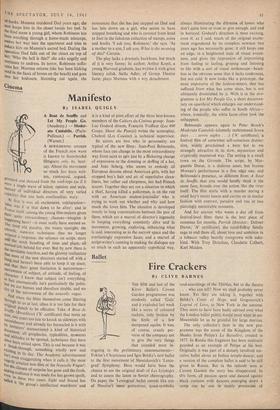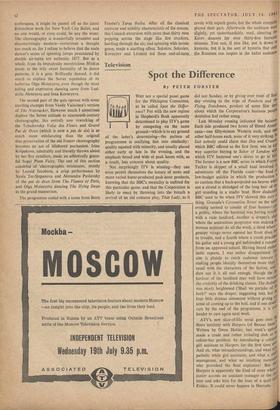Ballet
Fire Crackers
By CLIVE BARNES
soul-searchings of -the Thirties, but in the theatre . . . who can tell? Now we shall probably never know. Yet they are taking it, together with Belsky's Coast of Hope and Grigorovich's Legend of Love, to New York in the autumn. They seem to have been badly advised over what the London ballet public would most want to see. Meanwhile let us be grateful for large mercies.
The only collector's item in the new pro- gramme was the scene of the Kingdom of the Shades from Petipa's La Bayarlare, created in 1877. In Russia this fragment has been zealously guarded as an example of Petipa at his best. Originally it was part of a densely involved nar- rative ballet about an Indian temple-dancer, and a version of the complete ballet is said to be still given in Russia. But in the episode seen at Covent Garden the story has disappeared. In this form, all passion spent and danced against black curtains with dancers emerging down a ramp one by one in stately procession of arabesques, it might be passed off as the latest Balanchine work for New York City Ballet, and no one would, or even could, be any the wiser. The choreography is wonderfully inventive and disconcertingly modern—sometimes a thought too much so, for I refuse to believe that the male dancer's series of spinning jumps punctuated by double air-turns are authentic 1877. But as a whole, from its impudently meretricious Minkus music to the icily sweet formality of its dance patterns, it is a gem. Brilliantly danced, it did much to explain the Soviet reputation of its ballerina Olga Moiseyeva, even though the most telling and expressive dancing came from Lud- milla Alexeyeva and Irma Korneyeva.
The second part of the gala opened with some startling excerpts from Vasily Vainonen's version of The Nutcracker. However much I sometimes deplore the Soviet attitude to nineteenth-century choreography, this entirely new reworking of the Tchaikovsky Valse des Fleurs and Grand Pas de Dela (which is now a pas de six) is SO much more exhilarating than the original that preservation of the old Ivanov choreography becomes an act of blinkered puritanism. Irina Kolpakova, admirably and literally thrown about by her 'five cavaliers, made an athletically grace- ful Sugar , Plum Fairy. The rest of this section consisted of 'choreographic miniatures,' mostly by Leonid Jacobson, a crisp performance by Xenia Ter-Stepanova and Alexandre Pavlovsky of the pas de deux from The Flames of Paris, and Olga Moiseyeva dancing The Dying Swan in the grand mannerism.
The programme ended with a scene from Boris Fenster's Taras Bulba. After all the classical restraint and nobility characteristic of the season, this Cossack excursion with more than thirty men popping across the stage like fire crackers, hurtling through the air, and spinning with heroic grace, made a startling effect. Sokolov, Soloviev, Korneyev and Livshitz led these end-of-term revels with superb gusto, but the whole companY played their part. Afterwards the audience went slightly, yet understandably, mad, cheering the' Kirov dancers for over thirty-five fantastic minutes. You can, if you like, put it down to hysteria; but it is the sort of hysteria that onlY the Russians can inspire in the ballet audience.



































 Previous page
Previous page